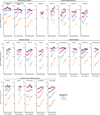Prostate cancer incidence in 43 populations worldwide: An analysis of time trends overall and by age group
- PMID: 26488767
- PMCID: PMC4712103
- DOI: 10.1002/ijc.29894
Prostate cancer incidence in 43 populations worldwide: An analysis of time trends overall and by age group
Abstract
Prostate cancer is a significant public health burden and a major cause of morbidity and mortality among men worldwide. Analyzing geographic patterns and temporal trends may help identify high-risk populations, suggest the degree of PSA testing, and provide clues to etiology. We used incidence data available from the International Agency for Research on Cancer (IARC) and certain cancer registries for 43 populations across five continents during a median period of 24 years. Trends in overall prostate cancer rates showed five distinct patterns ranging from generally monotonic increases to peaking of rates followed by declines, which coincide somewhat with changes in the prevalence of PSA testing. Trends in age-specific rates generally mirrored those in the overall rates, with several notable exceptions. For populations where overall rates increased rapidly and then peaked, exemplified in North America and Oceania, the highest incidence tended to be most pronounced and occurred during earlier calendar years among older men compared with younger ones. For populations with almost continual increases in overall rates, exemplified in Eastern Europe and Asia, peaks were evident among men aged ≥ 75 years in many instances. Rates for ages 45-54 years did not clearly stabilize or decline in the majority of studied populations. Global geographic variation remained substantial for both overall and age-specific incidence rates regardless of levels of PSA testing, with the lowest rates consistently in Asia. Explanations for the persistent geographic differences and the continuing increases of especially early-onset prostate cancer remain unclear.
Keywords: age-specific; incidence; international; prostatic neoplasms; trends.
© 2015 UICC.
Figures




References
-
- Ferlay JSI, Ervik M, Dikshit R, Eser S, Mathers C, Rebelo M, Parkin DM, Forman D, Bray F. GLOBOCAN 2012 v1.0, Cancer incidence and mortality worldwide: IARC CancerBase No. 11[Internet] Lyon, France: International Agency for Research on Cancer; 2013.
-
- Etzioni R, Berry KM, Legler JM, Shaw P. Prostate-specific antigen testing in black and white men: An analysis of Medicare claims from 1991–1998. Urology. 2002;59:251–255. - PubMed
-
- Potosky AL, Kessier L, Gridley G, Brown CC, Horm JW. Rise in prostatic cancer incidence associated with increased rse of transurethral resection. Journal of the National Cancer Institute. 1990;82:1624–1628. - PubMed
-
- Kvale R, Auvinen A, Adami HO, Klint A, Hernes E, Moller B, Pukkala E, Storm HH, Tryggvadottir L, Tretli S, Wahlqvist R, Weiderpass E, et al. Interpreting trends in prostate cancer incidence and mortality in the five Nordic countries. J Natl Cancer Inst. 2007;99:1881–1887. - PubMed
-
- Neppl-Huber C, Zappa M, Coebergh JW, Rapiti E, Rachtan J, Holleczek B, Rosso S, Aareleid T, Brenner H, Gondos A. Changes in incidence, survival and mortality of prostate cancer in Europe and the United States in the PSA era: additional diagnoses and avoided deaths. Ann Oncol. 2012;23:1325–1334. - PubMed
Publication types
MeSH terms
Grants and funding
LinkOut - more resources
Full Text Sources
Other Literature Sources
Medical
Research Materials
Miscellaneous

